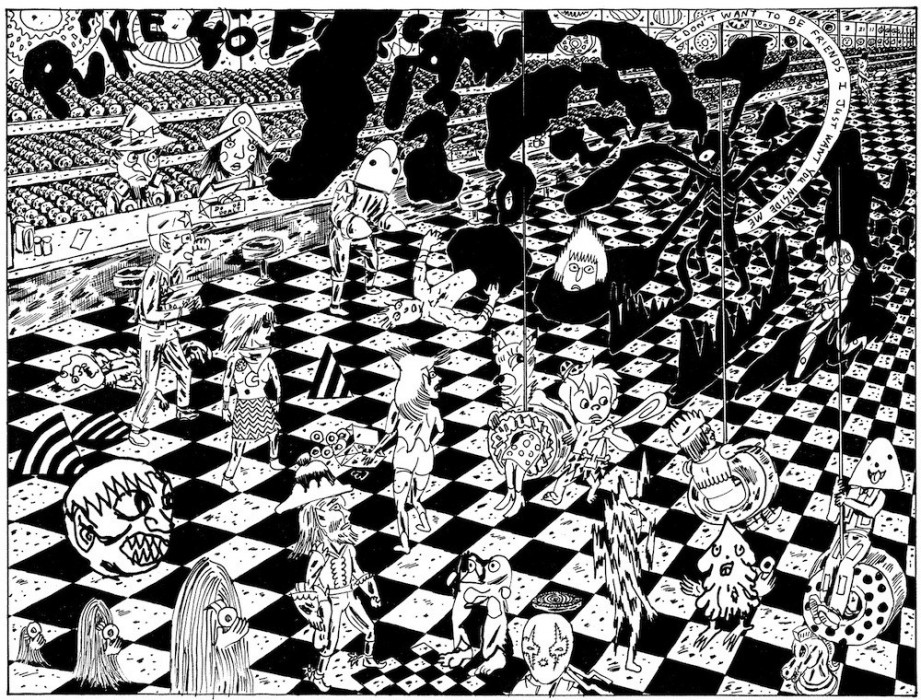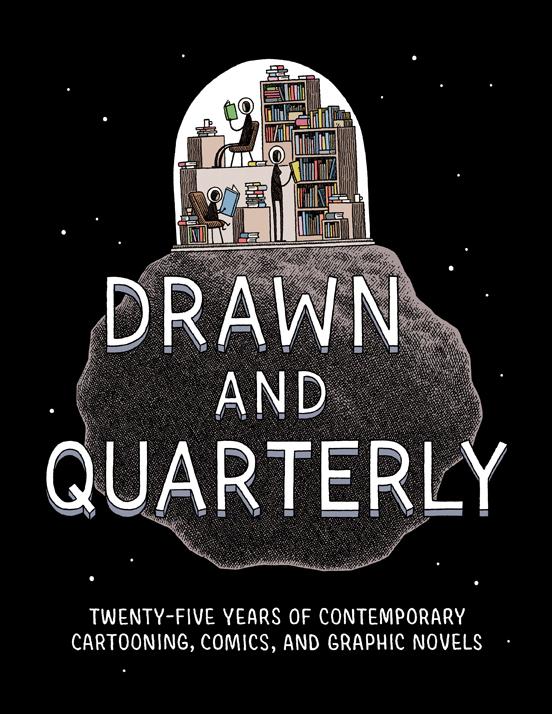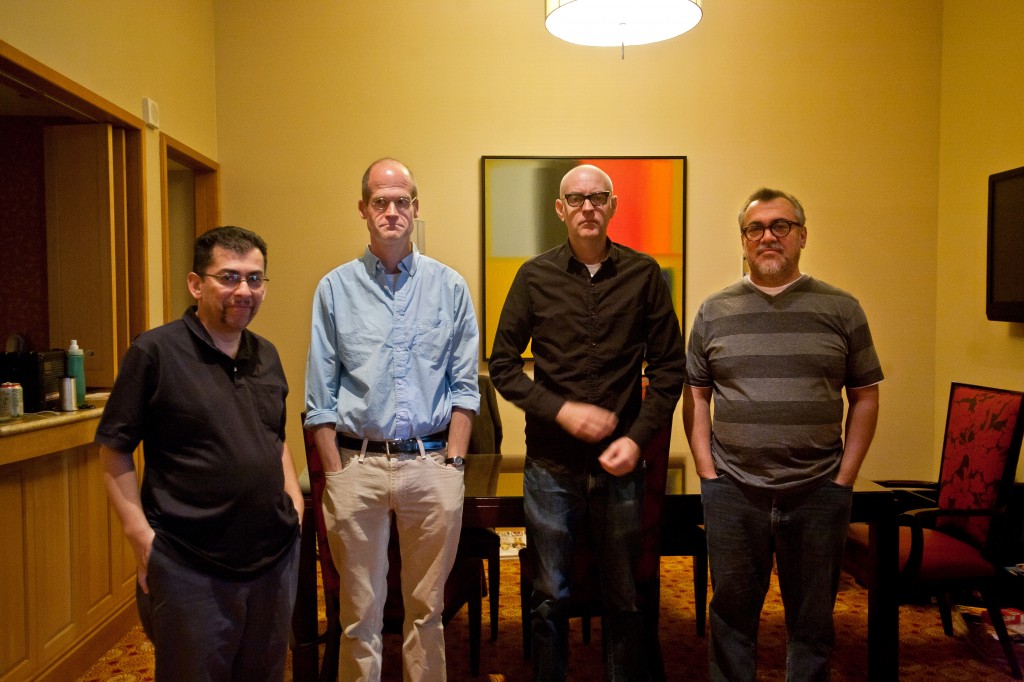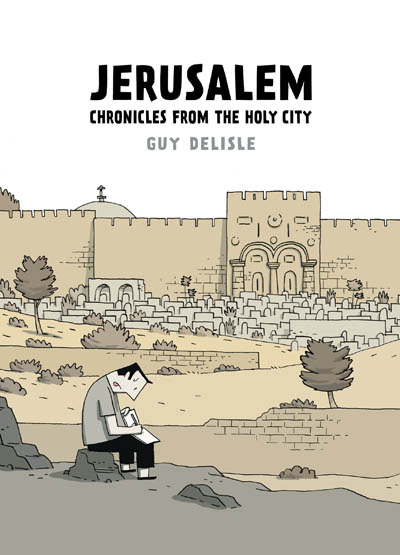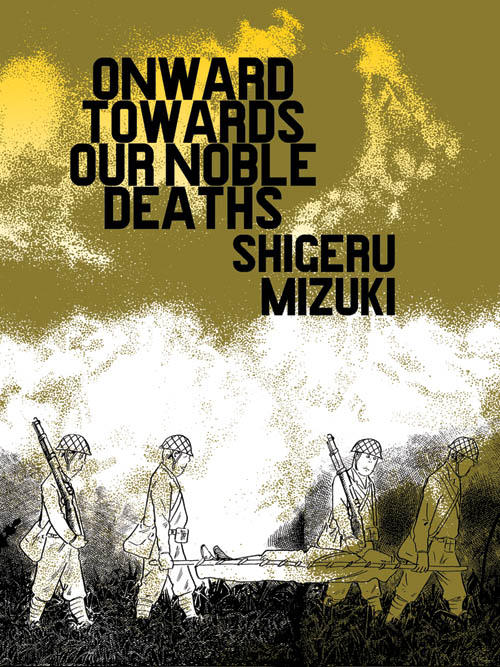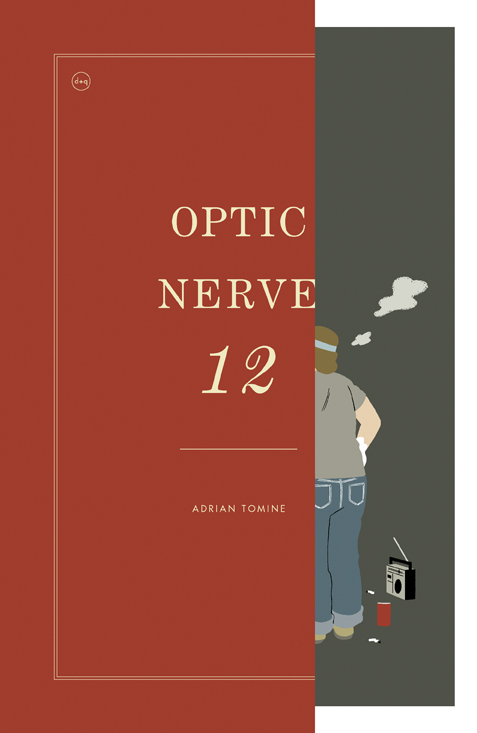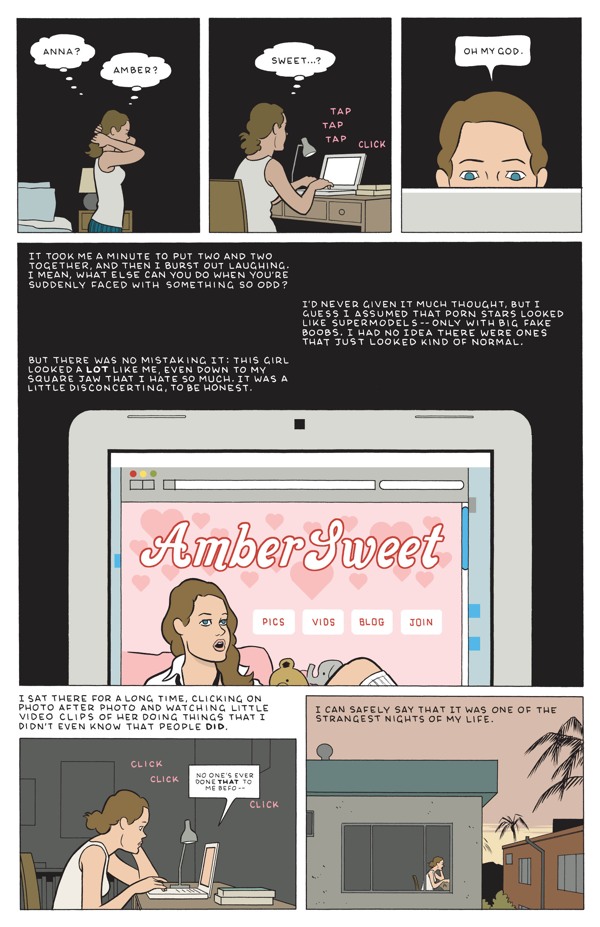Posts Tagged ‘Drawn and Quarterly’
Eat This Book: ‘BoJack Horseman’ Artist Lisa Hanawalt Takes Her ‘Hot Dog Taste Test’
June 16, 2016I had the impression going in that this is “Lisa Hanawalt’s Food Book,” but having read it’s like your real subject is how it feels to inhabit a physical body. The food angle is just there to whet your appetite. So to speak.
You totally found me out. This book is an edible Trojan horse? But yes, it could have been called Here’s a Pile of Stuff Lisa Felt Like Making Over the Last Few Years and Most of It Is Related to Food, but people tend to want a tighter concept before committing to reading an entire book.
[…]
One aspect of physicality it doesn’t address much is sex. There are a couple of allusions, and a lot of sex-adjacent body parts, but it’s much more about eating, shitting, peeing, menstruating, traveling, riding, feeling full, getting sick…
That’s a good point, because I haven’t been one to shy away from sex in the past. Maybe it’s a subconscious attempt at making something sliiiightly less creepy, and to let people dig for my hornier work if they’re true fans? Maybe I’m just going through a bowel phase, the way Picasso had a blue period? I’m also a little grossed out when food and sex are combined, honestly.
“Puke Force” Is a Graphic Novel About Online Groupthink and Lone-Wolf Terrorism
February 21, 2016VICE: If I didn’t know any better I’d read this book as a warning to kids about the dangers of online. Not that it’s preachy, but the constant connectedness goes hand-in-hand with surveillance, and with the spread of destructive ideas.
Brian Chippendale: People are definitely reading a heavy warning about online activity in the book, and I think that’s one regret I have. I love the Internet. [Laughs] I’ve gotten so much practical use out of it: Selling prints, booking tours, saying hey to old friends—all that. But I do feel that even though I have an overt need for and warmth toward some social media, there is an undercurrent of energy on there that corrodes the soul.
What do you mean by “corrodes the soul”?
I think it’s the feeling that you’re not alone anymore. That should be a positive thing, right? But I think aloneness is important. It’s very important to get lost in your own head, not just get lost in the hive mind. As an artist, I need to venture inside to get at deeper meaning. Maybe new muscles for that are forming in younger people, new ways to go deep. I don’t necessarily think we are going to lose a generation to the internet. It’s an amazing tool. Pizza delivery drones, on the other hand? I’ll definitely be throwing rocks at them… and ordering pizzas.
DQ25
June 2, 2015I interviewed the great editor and publisher Tom Devlin in this beautiful book about Drawn and Quarterly, one of the best and most important comics publishers of all time. It’s out today, and it’s filled with comics by wonderful cartoonists. Check it out!
The Four Horsemen
September 26, 2012I interviewed Jaime Hernandez, Chris Ware, Daniel Clowes, and Gilbert Hernandez for Rolling Stone. Comics game Mount Rushmore.
(photo by Meredith Rizzo)
Comics Time: Jerusalem
June 18, 2012Jerusalem
Guy Delisle
Drawn and Quarterly, 2012
320 pages
$24.95
Buy it from D&Q
Buy it from Amazon.com
For today’s Comics Time review, please visit The Comics Journal.
Comics Time: Onward Towards Our Noble Deaths
February 20, 2012Onward Towards Our Noble Deaths
Shigeru Mizuki, writer/artist
Drawn and Quarterly, 2011
368 pages
$24.95
Buy it and read a preview from D&Q
Buy it from Amazon.com
Here’s a book with a hugely important message to which I am very sympathetic, which is never less than enjoyable to read or look at, which I nevertheless didn’t get a ton out of, in the end. A fictionalized memoir of Mizuki’s participation in the Japanese military’s ill-fated attempt to repel invading American forces from a South Pacific island, Onward Towards Our Noble Deaths alternates between expressively cartooned vignettes among the troops that show off Mizuki’s incongruously cute, oblong/oval-headed character designs — seriously, it’s like an army of Berts from Sesame Street — with powerful, passionately drawn photorealistic depictions of both the tropical island environment and the carnage it comes to house. Mizkuki’s disgust with the who-gives-a-fuck pointlessness of the men’s mission, and the callousness with which the commanding officers order the men into suicide runs when the mission inevitably fails, is palpable; interestingly, it comes through equally well in the black-comic cartoony material, which depict the forces’ slow attrition through disease, accidents, enemy forces, and even animal attacks, and in the astonishingly proficient hatching of the realistic scenes, wordless depictions of the island and the ocean and the spectral American G.I.s who bring death to them both. But the characters are more or less incidental to the book’s agenda — few of them are developed any more than is necessary to convey the idea that it was a waste to send this or that funny or annoying or brave or totally ordinary guy to his death for no reason — and thus the book can only get the emotional hooks required for that idea to connect into you in the abstract. If you already believe that war is hell, I’m not sure this book will enlighten you further, certainly not the way it did when it was initially released in Japan in the ’70s. But there’s one aspect that stuck out to me beyond the basics: The suicide-charge ethic of the Imperial Army comes across as a bizarre ideology simply grafted on top of an army full of regular guys, who complain and help each other out and badmouth the officers and make dirty jokes same as any other army, banzai or no. And in that sense, it makes you wonder what people half a world and half a century away from us will think of the ideologies that drove us to kill and die, too.
Comics Time: Optic Nerve #12
February 16, 2012Optic Nerve #12
Adrian Tomine, writer/artist
Drawn and Quarterly, 2011
40 pages
$5.95
Buy it from D&Q
Read a preview at Boing Boing
Man, is this thing ever happy to be a comic book.
The format of a comic doesn’t matter to me a whole lot, unless the format in question is notably detrimental to the comic it houses. I like the idea of serial alternative comic book series mostly for the promise of seeing a lot of work from alternative cartoonists on a regular basis, but today that need is met by the web. (Which can’t meet all needs, to be sure — it doesn’t meet the need of retailers to have that kind of material showing up fresh every few months and consequently attracting a different clientele to the shops on Wednesdays, but that’s not my bailiwick.) But in Optic Nerve #12, Adrian Tomine reminded me what can make an alt-comic such an attractive and pleasurable way of packaging material, something not even the most well-stocked RSS reader can provide.
In addition to the usual letters page, its weirdly personal mix of praise and criticism as po-facedly selected as always, the issue consists of three comics. The first, “Hortisculpture,” feels like an homage to the apparently final two issues of the greatest of the alternative comic books, arguably the two best single alternative comic book issues by anyone: Dan Clowes’s Eightball #22 and #23. Like them, the story is constructed from individual self-contained strips, in this case a full “week”‘s worth: six black-and-white four-panel strips plus a full-color “Sunday” page, over and over till the end of the story. Said story recounts a family-man landscaper’s quixotic career detour into the world of contemporary art via his own unique blend of sculpture and horticlture, an unappreciated (arguably unappreciatable) hybrid his pursuit of which upends his life. As a crypto-autobiography it’s a corker — a keyed-up, hyperreal representation of the travails of Tomine’s chosen form of self-imposed artistic marginalization. It’s as engrossing to watch him work his way through as, say, Gabrielle Bell’s similar fictionalizations of her family life. (Plus it allows Tomine’s customary preoccupation with the intersection of race and romance a new, markedly less hostile environment in which to flower.) Things have gone a lot better for the cartoonist than the hortisculptor, to be sure — the former just received some of the best notices of his career for the wide release of the comics he made about his marriage to the mother of his kid, while our last glimpse of the latter is of he and his daughter gleefully smashing his work to smithereens — but the anxieties underlying the worst-case-scenario comic are obviously real, and really funny. And once again like Clowes, in Eightball #22 and later in Wilson, Tomine’s working with a much “cartoonier” style — a curvier line, bulbous noses, dot eyes, doughier physiques — that enjoyably invokes similar work from Sammy Harkham or Chuck Forsman. It feels right, somehow, to look at art like this on a staple-bound page.
Next up is that staple of one-man anthology series, the reprint from some other anthology. In this case it’s Tomine’s “Amber Sweet” from the broadsheet-sized Kramers Ergot 7, attractively scaled down to the size of the floppy comic, its muted color scheme even more clearly centered around the nutmeg-colored hair of the young woman who discovers she’s the spitting image of the titular porn star. “Sweet” is fascinating to me in that it’s about how unsexy sex can be: our protagonist’s love life, and more besides, is basically destroyed by her resemblance to Amber, a resemblance the men in her life are either daunted by or way too into. Tomine’s perhaps uniquely suited to explore this plight: his cartooning is as sexy as it gets, I’ve always found — his line elegant, his compositions enticingly icy, his character designs very attractive, from Amber and her never-named doppelganger on down — but his work relentlessly cuts against that with the awkwardness and selfishness of his characters. Here we see a beautiful girl who looks like another beautiful girl who makes her living by taking her clothes off and having sex have sex herself as drawn by one of alternative comics’ great unsung sensualists, but the story denies us the pleasure on every possible level. It’s a blast to watch Tomine so successfully negotiate that obstacle course on the way to the story’s knockout ending, a beautiful and satisfying opening-up of the story’s emotional claustrophobia.
The third and final strip — two pages, 20-panel grids — is Tomine’s Lament, pretty much, a self-effacing mock-autobiographical strip about Tomine as “The Last Pamphleteer,” his adherence to the alt-comic format earning him the laughter of his peers and the indifference of his audience. And here, perhaps, he’s trying a little too hard. Throwing “tweet” into sneer quotes as if the term is an affectation instead of just, y’know, email or website; saying things like “I even liked it when the artist was obviously just trying to fill a few extra pages, and you’d get a pointless, dashed-off autobio strip or something!”, as if both he and we didn’t notice that he had to cram this thing onto the inside back cover to get it to fit; using D&Q publicist Peggy Burns as an antagonist, as if he weren’t still core Drawn and Quarterly artist Adrian Tomine; setting up Anders Nilsen and Kate Beaton as models for the new book-driven publishing model, as if they too weren’t primarily collecting work they published in smaller chunks elsewhere…He doth protest too much, and while the result is amusing, who needs it? He’s Adrian Tomine. He writes great and draws great and is as good at using his chosen format as anyone else is at using theirs. That’s all you need.
The 20 Best Comics of 2011
January 1, 201220. Uncanny X-Force (Rick Remender and Jerome Opeña, Marvel): In a year when the ugliness of the superhero comics business became harder than ever to ignore, it’s fitting that the best superhero comic is about the ugliness of being a superhero. Remender uses the inherent excess of the X-men’s most extreme team to tell a tale of how solving problems through violence in fact solves nothing at all. (It has this in common with most of the best superhero comics of the past decade: Morrison/Quitely/etc. New X-Men, Bendis/Maleev Daredevil, Brubaker/Epting/etc. Captain America, Mignola/Arcudi/Fegredo/Davis Hellboy/BPRD, Kirkman/Walker/Ottley Invincible, Lewis/Leon The Winter Men…) Opeña’s Euro-cosmic art and Dean White’s twilit color palette (the great unifier for fill-in artists on the title) could handle Remender’s apocalyptic continuity mining easily, but it was in silent reflection on the weight of all this death that they were truly uncanny.
19. The League of Extraordinary Gentlemen Vol. 3: Century #2: 1969 (Alan Moore and Kevin O’Neill, Top Shelf/Knockabout): I’ll admit I’m somewhat surprised to be listing this here; I’ve always enjoyed this last surviving outpost of Moore’s comics career but never thought I loved it. But in this installment, Moore and O’Neill’s intrepid heroes — who’ve previously overcome Professor Moriarty, Fu Manchu, and the Martian war machine — finally succumb to their own excesses and jealousies in Swinging London, allowing a sneering occult villain to tear them apart with almost casual ease. It’s nasty, ugly, and sad, and it’s sticking with me like Moore’s best work.
18. The comics of Lisa Hanawalt (various publishers): As I put it when I saw her drawing of some kind of tree-dwelling primate wearing a multicolored hat made of three human skulls stacked on top of one another, Lisa Hanawalt has a strange imagination. And it’s a totally unpredictable one, which is what makes her comics – whether they’re reasonably straightforward movie lampoons or the extravagantly bizarre sex comic she contributed to Michael DeForge and Ryan Sands’s Thickness anthology, as dark and damp as the soil in which its earthworm ingénue must live – a highlight of any given day a new one pops up.
17. Daybreak (Brian Ralph, Drawn and Quarterly): Fort Thunder’s single most accessible offspring also proves to be its bleakest, thanks to an extended collected edition that converts a rollicking first-person zombie/post-apocalypse thriller into a troubling meditation on the power of the gaze. Future artcomics takes on this subgenre have a high bar to clear.
16. Habibi (Craig Thompson, Pantheon): It’s undermined by its central characters, who exist mainly as a hanger on which this violent, erotic, conflicted, curious, complex, endlessly inventive coat of many colors is hung. But as a pure riot of creative energy from an artist unafraid to wrestle with his demons even if the demons end up winning in the end, Habibi lives up to its ambitions as a personal epic. You could dive into its shifting sands and come up with something different every time.
15. Ganges #4 (Kevin Huizenga, Coconino/Fantagraphics): Huizenga wrings a second great book out of his everyman character’s insomnia. It’s quite simple how, really: He makes comics about things you’d never thought comics could be about, by doing things you never thought comics could do to show you them. Best of all, there’s still the sense that his best work is ahead of him, waiting like dawn in the distance.
14. The Congress of the Animals (Jim Woodring, Fantagraphics): The potential for change explored by the hapless Manhog in last year’s Weathercraft is actualized by the meandering mischief-maker Frank this time around. While I didn’t quite connect with Frank’s travails as deeply as I did with Manhog’s, the payoff still feels like a weight has been lifted from Woodring’s strange world, while the route he takes to get there is illustrated so beautifully it’s almost superhuman. It’s the happy ending he’s spent most of his career earning.
13. Mister Wonderful (Daniel Clowes, Pantheon): Speaking of happy endings an altcomix luminary has spent most of his career earning! Clowes’s contribution to the late, largely unlamented Funny Pages section of The New York Times Magazine is briefly expanded and thoroughly improved in this collected edition. Clowes reformats the broadsheet pages into landscape strips, eases off the punchlines and cliffhangers, blows individual images up to heretofore unseen scales, and walks us through a self-sabotaging doofus’s shitty night into a brighter tomorrow.
12. The comics of Gabrielle Bell (various publishers): Bell is mastering the autobiography genre; her deadpan character designs and body language make everything she says so easy to buy – not that that would be a challenge with comics as insightful as her journey into nerd culture’s beating heart, San Diego Diary, just by way of a for instance. But she’s also reinventing the autobiography genre, by sliding seamlessly into fictionalized distortions of it; her black-strewn images give a somber, thoughtful weight to any flight of fancy she throws at us. What a performance, all year long.
11. The Armed Garden and Other Stories (David B., Fantagraphics): Religious fundamentalism is a dreary, oppressive constant in its ability to bend sexuality to mania and hammer lives into weapons devoted to killing. But it has worn a thousand faces in a millennia-long carnevale procession of war and weirdness, and David B. paints portraits of three of its masks with bloody brilliance. Focusing on long-forgotten heresies and treating the most outlandish legends about them as fact, B.’s high-contrast linework sets them all alight with their own incandescent madness.
10. Too Dark to See (Julia Gfrörer, Thuban Press): It was a dark year for comics, at least for the comics that moved me the most. And no one harnessed that darkness to relatable, emotional effect better than Julia Gfrörer. Her very contemporary take on the legend of the succubus was frank and explicit in its treatment of sexuality, rigorously well-observed in its cataloguing of the spirit-sapping modern-day indignities that can feed depression and destroy relationships, and delicately, almost tenderly drawn. It’s like she held her finger to the air, sensed all the things that can make life rotten, and cast them onto the pages. She made something quite beautiful out of all that ugly.
9. The comics and pixel art of Uno Moralez (self-published on the web at unomoralez.com): What if an 8-bit NES cut-scene could kill? The digital artwork of Uno Moralez — some of it standard illustrations, some of it animated gifs, some of it full-fledged comics — shares its aesthetic with The Ring‘s videotape or Al Columbia’s Pim & Francie: a horror so cosmically black, images so unbearably wrong, that they appear to have leaked into and corrupted their very medium of transmission. Moralez fuses crosses the streams of supernatural trash from a variety of cultures — the legends and Soviet art of his native Russia, the horror and porn manga of Japan, the B-movies and horror stories of the States, the formless sensation aesthetic of the Internet itself — into a series of images that is impossible to predict in its weirdness but totally unflagging in its sense that you’d be better off if you’d never laid eyes on it. I can’t wait to see more.
8. The comics of Michael DeForge (various publishers): The last time you saw a cartoonist this good and this unique this young, you were probably reading the UT Austin student newspaper comics section and stumbling across a guy named Chris Ware. All four of DeForge’s best-ever comics — his divorced dad story in Lose #3, his shape-shifting/gender-bending erotica in Thickness #2, his self-published art-world fantasia Open Country, and his gorgeously colored body-horror webcomic Ant Comic — came out this year, none of them looking anything at all like anything you could picture before seeing your first Michael DeForge comic. It’s almost frightening to think where he’ll be five years from now, ten years from now…or even just this time next year.
7. The comics and art of Jonny Negron (various publishers): What if someone took Christina Hendricks’s walk across the parking lot and trip to the bathroom in Drive and made an entire comics career out of them? That is an enormously facile and reductive way to describe the disturbing, stylish, sexy, singular work of Jonny Negron, the breakout cartoonist of the year, but it at least points you in the right direction. No one’s ever thought to combine his muscular yet curiously dispassionate bullet-time approach to action and violence, his Yokoyama-esque spatial geometry, his attention to retrofuturistic fashion and style, his obvious love of the female body in all its shapes and sizes, and his ambient Lynchian terror; even if they had, it’d be tough to conceive of anyone building up his remarkable body of work in such a short period of time. Open up your Tumblr dashboard or crack an anthology (Thickness, Mould Map, Study Group, Smoke Signal, Negron and Jesse Balmer’s own Chameleon), and chances are good that Negron was the weirdest, best, most coldly beautiful thing in it. It’s like a raw, pure transmission from a fascinating brain.
6. The Wolf (Tom Neely, I Will Destroy You): Neely’s wordless, painted, at-times pornographic graphic novel feels like the successful final draft to various other prestigious projects’ false starts. It’s a far less didactic, more genuinely erotic attempt at high-art smut than Dave McKean’s Celluloid; a less self-conscious, more direct attempt at frankly depicting both the destructive and creative effects of sex on a relationship via symbolism than Craig Thompson’s Habibi; a blend of sex and horror and narrative and visual poetry and ugly shit and a happy ending that succeeds in each of these things where many comics choose to focus on only one or two.
5. The Cardboard Valise (Ben Katchor, Pantheon): Prep your time capsules, folks: You’d be hard pressed to find an artifact that better conveys our national predicament than Ben Katchor’s latest comic-strip collection, a series of intertwined vignettes created largely before the Great Recession and our political class’s utter failure to adequately address it, but which nonetheless appears to anticipate it. Its message — that blind nationalism is the prestige of the magic trick used by hucksters to financially and culturally ruin societies for their own profit — is delightfully easy to miss amid Katchor’s remarkable depictions of lost fads, trends, jobs, tourist attractions, and other detritus of the dying American Century. He’s the very most funnest Cassandra around.
4. Love from the Shadows (Gilbert Hernandez, Fantagraphics): I picture Gilbert Hernandez approaching his drawing board these days like Lawrence of Arabia approaching a Turkish convoy: “NO PRISONERS! NO PRISONERS!” In a year suffused with comics funneling pitch-black darkness through a combination of sex and horror, none were blacker, sexier, or more horrific than this gender-bending exploitation flick from Beto’s “Fritz-verse.” None also functioned as a rejection of the work that made its creator famous like this one did, either. Not a crowd-pleaser like his brother, but every bit as brilliant, every bit as fearless.
3. Garden (Yuichi Yokoyama, PictureBox): Like a theme park ride in comics form — with the strange events it chronicles themselves resembling a theme park ride — Yokoyama’s book is a breathtaking, breathless experience. Alongside his anonymous but extravagantly costumed non-characters, we simply go along for the ride, exploring Yokoyama’s prodigious, mysterious imagination as he concocts a seemingly endless stream of increasingly strange interfaces between man and machine, nature and artifice. As a metaphor for our increasingly out-of-control modern life it’s tough to top. As pure thrilling kinetic cartooning it’s equally tough to top.
2. Big Questions (Anders Nilsen, Drawn & Quarterly): Last year, I wrote that if the collected edition of Nilsen’s long-running parable of philosophically minded birds and the plane crash that turns their lives upside-down didn’t top my list whenever it came out, it must have been some kind of miracle year. Turns out that it was. But you’d pretty much have to create a flawless capstone to a thirty-year storyline of neer-peerless intelligence and artistry to top this colossal achievement. Nilsen’s painstaking, pointillist cartooning and ruthless examination of just how little regard the workings of the world have for any given life, human or otherwise, marks him as the best comics artist of his generation, and solidifies Big Questions‘ claim as the finest “funny animal” comic since Maus.
1. Love and Rockets: New Stories #4 (Gilbert and Jaime Hernandez, Fantagraphics): Gilbert got his due elsewhere on my list, so let’s ignore his contribution to this issue, which advance the saga of his bosomy, frequently abused protagonist Fritz Martinez both on and off the sleazy silver screen. Instead, let’s add to the chorus praising Jaime’s “The Love Bunglers” as one of the greatest comics of all time, the point toward which one of the greatest comics series of all time has been hurtling for thirty years. In a single two-page spread Jaime nearly crushes both his lovable, walking-disaster main characters Maggie and Ray with the accumulated weight of all their decades of life, before emerging from beneath it like Spider-Man pushing up from out of that Ditko machinery. You can count the number of cartoonists able to wed style to substance, form to function, this seamlessly on one hand with fingers to spare. A masterpiece.
Comics Time: Paying For It
April 5, 2011Paying For It
Chester Brown, writer/artist
Drawn & Quarterly, April 2011
292 pages, hardcover
$24.95
Buy it from D&Q
Buy it from Amazon.com
My publishers wanted this book to be called PAYING FOR IT. I don’t like the title — there’s an implied double-meaning. It suggests that not only am I paying for sex but I’m also paying for being a john in some non-monetary way. Many would think that there’s an emotional cost — that johns are sad and lonely. There’s a potential health cost if one contracts a sexually transmitted disease. There’s a legal cost if one is arrested. If one is “outed,” then one could lose one’s job and also suffer the social cost of losing one’s friends and family. I haven’t been “paying for it” in any of those ways. I’m very far from being sad or lonely, I haven’t caught an S-T-D, I haven’t been arrested, I haven’t lost my c areer, and my friends and family haven’t rejected me (although I should admit that I still haven’t told my step-mom.
So far, I’ve been paying in only the one sense. (Since this is a memoir, “so far” is all that’s relevant.)
But let me be clear that my publishers did not force the title on me. I chose to give in to what they wanted. If I had insisted, they would have allowed me to put whatever words I wanted on the cover. I love and respect Chris and Peggy and realize that this is a difficult book to market.
–Chester Brown, in the entry pertaining to the Cover in the “Notes” section of Paying For It
“Difficult book to market”? Get outta town, Chet! When a review copy arrived at my house unexpectedly this Saturday, I tweeted, and quite seriously meant it when I did so, that having an infant in the neonatal intensive care unit was literally the only thing stopping me from dropping everything and reading this book right then and there. A parametric memoir from Chester Brown, the parameters of which were one of the great North American cartoonist’s experiences with prostitution? Appointment reading! Maybe it’s tough to market to the great unwashed, but you’d have to pry this thing out of my hands to keep me away.
As it turns out, Brown is right about the title his publishers selected. With its punning double meaning and slightly censorious elision of what, exactly, is being paid for, it’s all wrong for this straightfaced, blunt, even didactic sexual autobiography/soapbox lecture. “Paying for Sex” would be far more appropriate. Drop the cap from the “For” to make the phrase less idiomatic, insert the actual act back into the proceedings, and be as matter-of-fact and up-front as possible about what’s going on — which quality, not at all coincidentally, is a big part of why prostitution appeals so much to Brown in the first place. The social cues he seems unable to pick up on, the rituals he is congenitally incapable of performing, the years and decades of accrued guilt and sense of failure he built up from missing out on potential romantic or sexual relationships, the elaborate and to-him draining emotional quid pro quo of sex within the context of the few relationships he was able to enter into and maintain (that’s the context in which he really “paid for it”)…all of that disappeared the moment he told his first whore “Uh, I’d…like to have vaginal intercourse with you.” (“Yes, that’s what I really said,” he assures us helpfully in the “Notes” section.) It seems a shame to add a level of kabuki to the title of a book so fixated on taking it away.
This is not to say that humor has no place in the book. On the contrary, this thing is fucking hilarious. Much of this stems directly from how Brown draws what he draws. His Harold Gray tribute from Louis Riel has been abandoned (with the exception of Brown’s brother Gordon, who’s drawn like a Riel refugee). In its place are rigorous, unyielding two-column eight-panel grids filled with tiny, tiny people drawn in as smooth a line as you’re likely to see anywhere; “painstaking” is the word that comes to mind. Foremost among these tiny people is Brown himself; his self-caricature is gaunt to the point of skeletal, an impression enhanced by the pupil-hiding blank voids of his everpresent eyeglasses. (One of the “Notes” reveals that by a certain point in the narrative he’d begun wearing contact lenses, particularly when patronizing prostitutes, but he didn’t want to confuse the issue.) Seeing his eyeless face in three-quarter profile over and over and over and over and over again, page after page after page, is bizarrely hysterical after a while. It is the least sexy self-portrait possible — not just unsexy, but almost devoid of the energy one would think would be required to have sex at all. In the many scenes where Brown is accompanied by his best friends and fellow cartoonists Seth and Joe Matt, the portraiture gets funnier still. Watching the three bespectacled men — Brown balding and sullen, Matt babyfaced and effusive, Seth impossibly dapper and never without his suit, fedora, and cigarette — walk in lockstep down the city streets like some sort of morose urban Three Amigos is one of the unexpected comedic highlights of my comic-book year so far.
I know, I know: What about the fucking? Pretty funny too. Throughout the book Brown uses a sort of dilation effect to center one’s attention in each panel, tending to shade in the periphery of the panels with a circle of black, like an old silent movie. This is barely even noticeable until you hit the sex scenes, which tend to show a bareassed Brown silently thrusting away at the crotches of the whores in question, usually with several different physical configurations per encounter (which is to say per chapter, since each experience with a prostitute gets its own chapter). Before long Brown’s mid-coitus interior monologue features him calmly assessing the pros and cons of each prostitute — he thinks about how she stacks up against previous women he’s been with, whether or not to patronize them again, what kind of review he’ll give them on a website for clients of Toronto escorts, and so on. It’s so deadpan he might as well be in the produce aisle squeezing melons.
Which is the point. In the lengthy, handwritten prose section that ends the book — first a series of polemical Appendices detailing Brown’s exact position on the decriminalization (not legalization! keep the government out of it!) of prostitution and his responses to arguments against the profession, then a response from Seth to his depiction as a character in the book (“The truth is, Chester seems to have a very limited emotional range compared to most people. There does seem to be something wrong with him.”), then another series of Notes on various points of interest in the book — Brown advances an admittedly quixotic vision of a world where paying for sex is an utter commonplace, a practice so pervasive that the need for professional prostitutes is lessened because you or I would have no problem exchanging money for sex with our attractive friends and acquaintances and vice versa, the same way we might go to movies together or send a friendly email. The important thing to Brown isn’t just decriminalizing the supposed offense of giving or receiving money for sex, it’s deflating the romanticized aura of the act itself.
As you’ll learn at great length from Brown, both in monlogues within the comic and in the prose material appended to it, the book isn’t so much about prostitution in and of itself as it is about the way Brown has rejiggered his life in order to avoid the “evil” of romantic love, or “possessive monogamy” as he comes to exclusively put it. Unlike familial or friendship love, romantic love in its idealized form is exclusive — you love one person, that one person loves you, and neither of you is allowed to feel the feelings you have for one another or have the sex you have with one another with anyone else. This leads to jealousy, an emotion Brown views as immature and immensely destructive. The solution? Separate sex from its romantic context entirely. Have close friends and companions from whom you get all the benefits of friendship love, which is superior to romantic love anyway, and then have sex with people of whom your contractual obligation to whom ensures that you will have no further expectations, nor they of you. Sex is sacred, Brown argues — so it should be made available without stigma or shame to as many people as possible. What better way to accomplish this than cash?
So that’s the platform here. Brown wants to do away with romantic love, and prostitution has enabled him to do this.
Except for one jaw-dropping revelation he sneaks into the final eight pages’ worth of comics: UPDATE: Actual revelation redacted, but suffice it to say it calls into question, if not outright undermines, all the Big Ideas he’s been advancing all along. This is the key to the whole fucking thing, and he shoves it away in a single chapter! If this is the way life is to be lived in Brown World, then don’t we need to see how it’s lived if the entire project is to have any value? That’s where the rubber hits the road! So to speak!
And once you realize that Brown has pulled the knockout punch, so many other things you’d been willing to overlook due to his overall breathtaking candor and craft become harder to excuse. Every prostitute we meet, for example, is depicted as a faceless brunette. Now, it’s abundantly clear why he wouldn’t want to actually draw these women true to life even without his notes explaining this decision, but noting that he did in fact see prostitutes who weren’t pale brunettes doesn’t change the fact that that’s how he drew all of them — nor does it make the fact that he drew their naked bodies as accurately as possible but left them a faceless raven-haired horde otherwise any less unwittingly (?) revealing.
Then there’s the chapter where he has sex with a very young-looking, foreign-born prostitute who gasps in pain throughout intercourse: “That she seems to be in pain is kind of a turn-on for me, but I also feel bad for her. I’m gonna cut this short and cum quickly.” What a gentleman! In the Notes he reveals he was astonishingly naive — credulity-stretchingly so, to be honest, for someone who appears to be so well-educated in every other aspect of the literature of prostitution — about the existence of sex slaves, whom he continuously talks about as though kidnapping by force were the preferred method of harvesting them, as opposed to false-pretense illegal-immigrant indentured-servitude. “Was ‘Arlene’ a sex slave? She didn’t seem like one,” he shrugs in the Notes about this painful encounter, before quoting someone on how “outcall” prostitutes (those who come to your apartment) are unlikely to be sex slaves since they could always go for help instead. Anyone who’s watched a single episode of Law & Order: SVU or Dateline NBC could shoot this whole element of things so full of holes you could use it as a colander.
The thing is, like Brown, I don’t think the existence of sex slaves necessitates the continued illegality of prostitution, any more than the existence of labor slaves meant we should ban the harvesting of cotton or the performance of housework. He’s quite right to say that were prostitution decriminalized, law enforcement could focus on forced prostitution that much more readily. It’s the “forced” that matters, not the “prostitution.” But for a guy who’s so willing to extrapolate universal principles from his personal experiences — his mother’s disastrous, effectively lethal course of treatment for schizophrenia means schizophrenia doesn’t exist; his unhappy experiences with romantic relationships mean that romantic relationships are a categorical evil — he sure doesn’t mind leaping right the fuck past any personal experience, or those of anyone else, that might cause those principles harm. And, you know, hey, that’s how almost all of us live, to one extent or another (most of us not to the extent that we need to wonder whether or not a given sex partner is a sex slave, but to some extent at least). That’s human, and we forgive each other for it in life. In art? Art explicitly dedicated to the advancement of some philosophical and political truth? Then that’s the sort of thing you gotta pay for.

